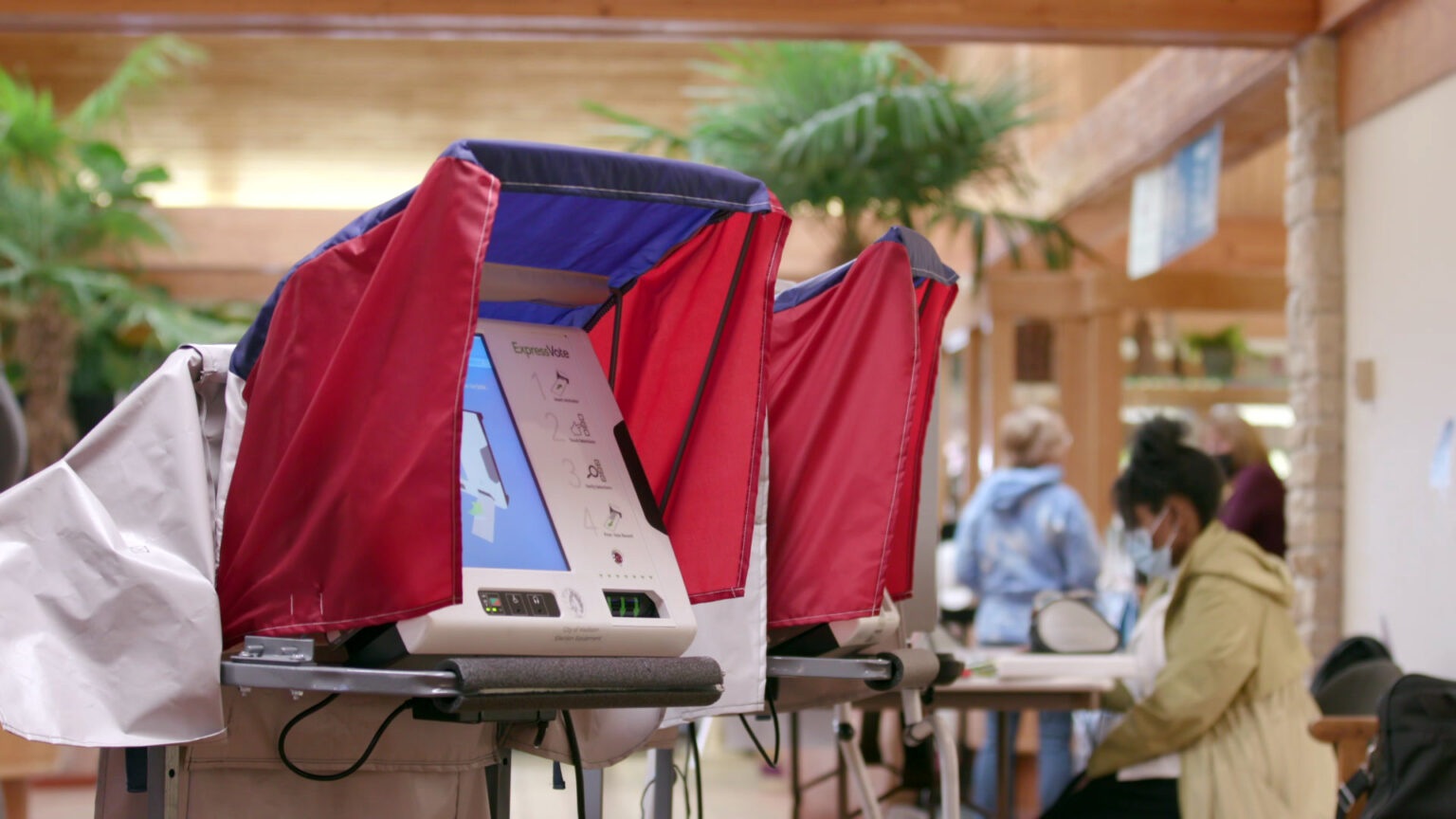Wisconsin's 2022 voter registrations up from 2018, absentee ballots down from 2020
Compared to the previous midterm election, the number of people registered to vote has grown considerably, but those casting their ballots absentee or early have likewise dropped since the previous presidential election.
November 3, 2022

Election workers assist voters at a Madison polling place on Oct. 25, 2022. The number of Wisconsinites casting early votes in the 2022 election cycle is down from the pandemic election in 2020, but up from the previous midterm in 2018. (Credit: PBS Wisconsin)
A review of state records checked about a week out from Election Day showed the number of Wisconsinites registered to vote in 2022 is larger than any previous midterm election. The data also shows the number of people voting by mail or voting early is higher than 2018, but much lower than 2020.
The Wisconsin Elections Commission regularly publishes voter registration and absentee return statistics, releasing reports for at least the past decade. Its reports show 3,531,456 Wisconsinites were registered to vote as of Nov. 1, and that 593,819 people had either returned an absentee ballot or voted early as of Nov. 2.
Voter registrations have climbed as the election has approached, with about 12,000 more as of Nov. 1 than one month earlier. Compared to 2020, these figures represent a slight decline in registered voters, but also a significant reduction in the number of people who voted before Election Day that year.
Wisconsin has a full slate of competitive races that will be decided Nov. 8, 2022, including the U.S. Senate race between incumbent Ron Johnson and challenger Mandela Barnes, the governor’s race between incumbent Tony Evers and challenger Tim Michels and the attorney general’s race between incumbent Josh Kaul and challenger Eric Toney.
As Election Day arrives, here is what Wisconsin’s voter registration and absentee figures reveal about trends that could influence turnout in November.
There are more absentee voters than in 2018, but far fewer than 2020
As of Nov. 2, there were 593,819 Wisconsin voters who had already cast their ballots for the 2022 election — over 170,000 more votes cast compared to the same point in 2018. However, there have been a whopping 950,000 fewer absentee votes cast when compared to 2020.
Midterm elections usually have different voting dynamics compared to presidential elections, and are typically characterized by fewer votes and lower turnout. Meanwhile, the 2020 presidential election was unique given intense voter interest in voting absentee rather than in-person due to the COVID-19 pandemic.
In November 2020 — during one peak in the pandemic — over 1.54 million people returned an absentee ballot or voted early nearly a week out from Election Day. That represents about 47% of all ballots cast in that election.
About 83% of 2022 absentee ballots sent have been returned as of Nov. 2 — 593,819 of the over 700,000 — which represents a slight decrease from the same point before the 2020 election, where the return rate was just over 84%.
In 2022, long after local mask mandates were lifted and vaccines have long been available, data suggests the number of people voting on Election Day may return closer to pre-pandemic levels.
Democratic stronghold counties have returned the most ballots so far
Milwaukee and Dane counties have returned the most absentee ballots — 97,144 and 89,902 respectively — of any county in the state as of Nov. 2. Included in that data are the largest number of early voters for those counties, with 37,399 and 32,494 ballots cast by the same date.
However, the 58 counties that saw majorities voting for Trump in 2020 have returned about 83,000 more absentee ballots than the 14 counties with majorities voting for Biden so far. That data also includes about 38,000 early votes.
Waukesha County has the most absentee and early votes of any county that voted for Trump in 2020, with 62,337 absentee ballots returned, including 30,235 early votes by Nov. 2.
Discerning clear patterns from this data can be somewhat ambiguous, highlighted by the 15 counties where majorities flipped from Democratic to Republican between 2018 and 2020. Wisconsin is a famously purple state in elections, with wide swaths of independent voters.
Democratic counties are voting early at a slightly higher rate
The 14 counties that voted for Biden have a slightly larger proportion of all votes cast so far in 2022 than they did for the 2020 election.
For every 10 early or absentee votes in a county that voted Republican in 2020, there were just over seven early or absentee votes from a county that voted Democratic. So far in 2022, for every 10 early or absentee votes in a Republican county, there are about seven-and-a-half votes from Democratic counties. That difference may not seem like much, but in a state as closely contested as Wisconsin, small differences in turnout could be meaningful.
Those numbers could be influenced by Republicans telling their supporters to wait until Election Day to vote.
Every age group except for 50-64 has more registered voters compared to 2018
There are almost 300,000 more registered voters in Wisconsin as of Nov. 1 compared to the same date in 2018, with the largest increase for the 65 and older age demographic. More than 130,000 people above the age of 65 are registered to vote compared to 2018.
Despite the large increase in registered voters, the age group of 50-64 has actually decreased by about 10,000 voters. Part of this decline may be due to a large number of baby boomers aging out of that group.
Meanwhile, compared to 2018, 18-24 year-olds have gained about 31,000 voters, 25-34 year-olds have gained about 56,000 voters and 35-49 year-olds have gained about 71,000 voters in terms of registrations
The deadline has passed to register online to vote in advance of the election, however eligible Wisconsinites can still register at polling places on Election Day. MyVote Wisconsin provides information about registering to vote, including valid forms of photo ID, which can include a Wisconsin driver’s license, Wisconsin Department of Transportation ID, military ID, tribal ID or a U.S. passport. Wisconsin is one of 22 states and jurisdictions that allows for same-day voter registration at polling locations on Election Day. More information about candidates is available at Wisconsin Vote.
Editor’s note: This item has been corrected with updated 2022 voting numbers that indicate early votes are included in the overall absentee ballot figures, and with additional information about differences between midterm and presidential election turnout.
 Passport
Passport











Follow Us